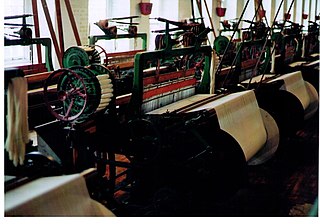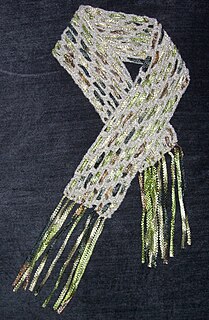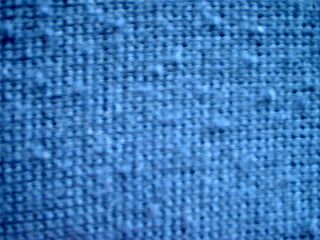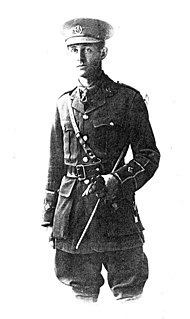Related Research Articles

A textile is a flexible material made by creating an interlocking bundle of yarns or threads, which are produced by spinning raw fibers into long and twisted lengths. Textiles are then formed by weaving, knitting, crocheting, knotting, tatting, felting, bonding, or braiding these yarns together.

Rayon is a semi-synthetic fiber, made from natural sources of regenerated cellulose, such as wood and related agricultural products. It has the same molecular structure as cellulose. It is also called Viscose. Many types and grades of viscose fibers and films exist. Some imitate the feel and texture of natural fibers such as silk, wool, cotton, and linen. The types that resemble silk are often called artificial silk.
Synthetic fibers or synthetic fibres are fibers made by humans through chemical synthesis, as opposed to natural fibers that are directly derived from living organisms, such as plants or fur from animals. They are the result of extensive research by scientists to improve upon naturally occurring animal and plant fibers. In general, synthetic fibers are created by extruding fiber-forming materials through spinnerets, forming a 'different' fiber. These are called synthetic or artificial fibers. Synthetic fibers are created by a process known as polymerization, which involves combining monomers to make a long chain or polymer. The word polymer comes from a Greek prefix "poly" which means "many" and suffix "mer" which means "single units".. There are two types of polymerization: linear polymerization and cross-linked polymerization...

A power loom is a mechanized loom, and was one of the key developments in the industrialization of weaving during the early Industrial Revolution. The first power loom was designed in 1786 by Edmund Cartwright and first built that same year. It was refined over the next 47 years until a design by the Howard and Bullough company made the operation completely automatic. This device was designed in 1834 by James Bullough and William Kenworthy, and was named the Lancashire loom.

The textile industry is primarily concerned with the design, production and distribution of yarn, cloth and clothing. The raw material may be natural, or synthetic using products of the chemical industry.
The textile industry of the city of Ahmedabad in the state of Gujarat in India dates back to the 19th century, when the city and the industry was established under the British raj. Textile mills employed thousands of people from across the state, and the cotton garments manufactured were exported around the world. The prosperity of the industry was the mainstay of the city's economy. It is called the "Manchester of India". Thus, the Ahmedabad is officially famous for cotton textile works.
Morada Limited is a textile company based in Altham, Lancashire. Morada specializes in curtains.

Arthur James Turner, CBE, FTI was a British scientist who worked in the field of textile technology. He was the first director of the Technological Laboratory created by the Indian Central Cotton Committee (ICCC) in Bombay in 1924. He was awarded the Warner Memorial Medal by the Textile Institute in 1931 in recognition of outstanding work in textile science and technology and was appointed to the CBE in 1950.

The Shirley Institute was established in 1920 as the British Cotton Industry Research Association at The Towers in Didsbury, Manchester, as a research centre dedicated to cotton production technologies. It was funded by the Cotton Board through a statutory levy. A significant contribution to the purchase price of The Towers was made by William Greenwood, the MP for Stockport, who asked that the building be named after his daughter. The Institute developed Ventile, a special high-quality woven cotton fabric. It also developed the tog as an easy-to-follow measure of the thermal resistance of textiles, as an alternative to the SI unit of m2K/W.

Bamboo textile is any cloth, yarn or clothing made from bamboo fibres. While historically used only for structural elements, such as bustles and the ribs of corsets, in recent years different technologies have been developed that allow bamboo fibre to be used for a wide range of textile and fashion applications.

A pill, colloquially known as a bobble, fuzzball, or lint ball is a small ball of fibers that forms on a piece of cloth. Pill is also a verb for the formation of such balls.
The Tun Abdul Razak Research Centre, originally known as the British Rubber Producers' Research Association, carries out research into rubber and is funded by the Malaysian government.

Century Textile and Industries is a textile and paper manufacturing and export company based in Mumbai. The main business activity involves manufacture of cotton textiles, yarn, denim, viscose filament rayon yarn, tire-cords, caustic soda, sulphuric acid, salt, pulp, and paper. The company also has a substantial dominance in the international textile markets and exports its products to more than 45 countries around the globe.
The Cotton Board was an organisation to oversee the organisation, research, marketing and promoting the cotton textile industry mainly based in Lancashire and Glasgow. It existed from 1940, and as a statutory Industrial Development Board from 1948 to 1972, known in its last years as the Textile Council.

John Wilson, CBE, MC & Bar, FRIC was Director of the British Rayon Research Association from 1948 to 1958. He was married to Edith Wilson and had six children.
Leonard Albert Wiseman OBE BSc ARI.C CText FTI was an organic chemist, scientific intelligence analyst and scientific administrator. Following his early work as a research chemist and in intelligence, he became, successively Deputy Director of the Atomic Weapons Research Establishment, Director of the British Rayon Research Association, succeeding John Wilson, Deputy Director of the Cotton, Silk and Man-made Fibres Research Association when the BRRA merged with the British Cotton Industry Research Association, becoming Director in 1969 until retiring in 1980. He also served for some years as Chairman of Council of the Textile Institute.
Professor Leslie Ronald George Treloar, OBE was a leading figure in the science of rubber and elasticity, and writer of a number of influential texts.

The history of cotton can be traced to domestication. Cotton played an important role in the history of India, the British Empire, and the United States, and continues to be an important crop and commodity.

Cuprammonium rayon is a rayon fiber made from cellulose dissolved in a cuprammonium solution, Schweizer's reagent.
The textile industry is the largest manufacturing industry in Pakistan. Pakistan is the eighth largest exporter of textile commodities in Asia. Textile sector contributes 8.5% to the GDP of Pakistan. In addition, the sector employs about 45% of the total labor force in the country. Pakistan is the fourth largest producer of cotton with the third largest spinning capacity in Asia after China and India and contributes 5% to the global spinning capacity. At present, there are 1,221 ginning units, 442 spinning units, 124 large spinning units and 425 small units which produce textile.
References
- ↑ The Times, November 29, 1946 page 10
- ↑ "Cotton Industry (Development Council)". TheyWorkForYou. Retrieved 4 December 2021.
- 1 2 The Times, John Wilson obituary, 15 September 1976
- 1 2 "Polymer Journal, 50th Anniversary site". Archived from the original on 3 July 2011. Retrieved 2 January 2011.
- ↑ The British computer industry: crisis and development By Tim Kelly, page 41
- ↑ "Archived copy". Archived from the original on 6 May 2011. Retrieved 2 January 2011.
{{cite web}}: CS1 maint: archived copy as title (link) - ↑ Journal of Education, Vol 81, 1949
- ↑ The Times, 12 May 1955
- ↑ "Duke At British Rayon Research". British Pathé. 16 September 2012. Archived from the original on 16 September 2012. Retrieved 4 December 2021.
- ↑ The Times, 18 February 1957, page 15
- ↑ "Cotton and Rayon Associations". hansard.millbanksystems.com. Retrieved 4 December 2021.
- ↑ "Len Wiseman obituary, TI News, Textile Institute 2009" (PDF). Archived from the original (PDF) on 17 February 2011. Retrieved 3 January 2011.
- ↑ "Lives in brief". thetimes.co.uk. 28 July 2008. Retrieved 4 December 2021.
- ↑ Tanner, Roger I.; Walters, K. (1998). Rheology : An Historical Perspective. Amsterdam: Elsevier. ISBN 978-0444829450.